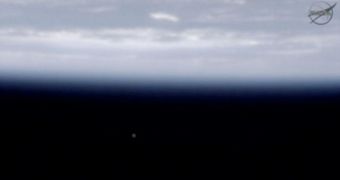Today, May 24, saw the first-ever, privately built spacecraft flying past the International Space Station. The point of closest approach between the two vehicles was reached at 7:25 am EDT (1125 GMT).
The unmanned Dragon space capsule first fired its engines to complete this maneuver at 4:43 am EDT (0843 GMT). Once this objective was complete, the spacecraft got within 40 kilometers (25 miles) of the orbital lab, but in an orbit around 2.5 kilometers (1.6 miles) lower.
A second engine firing occurred at 7:25 am EDT (1125 GMT), taking the Dragon through the R bar, an imaginary boundary line connecting the ISS to Earth. The capsule then carried on, moving away from the outpost, ahead of a planned docking attempt tomorrow, May 25.
Whether or not NASA will grant permission for this second stage of the mission to go forward still remains to be seen, but officials at the Space Exploration Technologies Corporation (SpaceX) are hopeful that the American space agency will sanction their attempt.
Dragon was launched to space aboard a Falcon 9 medium-lift delivery system, from Space Launch Complex 40 (SLC-40) at the Cape Canaveral Air Force Station, in Florida. Takeoff occurred at 03:44 am EDT (0744 GMT) on Tuesday, May 22.
As the SpaceX vehicle was approaching the space lab, engineers at the company conducted a series of tests on the capsule's navigation and communications instruments, in order to determine whether or not it was safe to move Dragon closer to the space station.
The ISS took $100 billion and 11 years to build, in an international project including 5 of the world's largest space agencies – NASA, RosCosmos, ESA, CSA and JAXA, Space reports. Therefore, it's security and that of its crew are the most important aspects of this docking attempt.
“Even though this is a test flight, Dragon is carrying up quite a bit of supplies; these are basically non-essential supplies just because it is a test flight,” explained NASA commentator, Josh Byerly.
The spacecraft is carrying batteries, a laptop, a student science experiment, food, clothing, water and other items for the members of Expedition 31 to the ISS. The vehicle itself is around 4.4 meters (14.4 feet) tall and 3.7 meters (12 feet) in diameter at its widest point.

 14 DAY TRIAL //
14 DAY TRIAL //